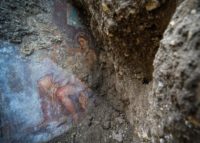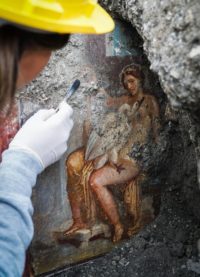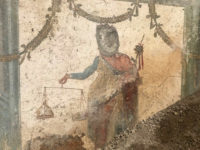 If it seems like the excavation of Pompeii’s Regio V is generating international headlines once a month, that’s because it is. The last discovery is a beautiful fresco depicting the mythological interspecies impregnation of Leda by Zeus in the guise of a swan. It was found on the wall of a cubiculum (bedroom) during stabilization work on buildings fronting the Via del Vesuvio. The bedroom is near a corridor where a fresco of Priapus weighing his phallus was found last summer.
If it seems like the excavation of Pompeii’s Regio V is generating international headlines once a month, that’s because it is. The last discovery is a beautiful fresco depicting the mythological interspecies impregnation of Leda by Zeus in the guise of a swan. It was found on the wall of a cubiculum (bedroom) during stabilization work on buildings fronting the Via del Vesuvio. The bedroom is near a corridor where a fresco of Priapus weighing his phallus was found last summer.
The fresco is likely inspired by a famous Greek statue by the 4th century B.C. sculptor Timotheus depicting Leda, artfully draped so as to be basically naked without technically being naked, protecting her god/swan lover from an eagle swooping down on him. While the statues have Leda standing and she’s languidly seated in the fresco, the combination of the gossamer fabric “covering” one breast and the heavier folds caught between her thighs is characteristic of Timotheus’ style.
 In the newly-discovered fresco, the swan in on her lap facing her, his swimsuit area very clearly positioned directly against hers. Leda looks directly out at the viewer with a sensual, alluring gaze. The mythological motif is used to create erotically stimulating decor for the bed chamber where, as Massimo Osanna, Director of the Archaeological Park of Pompeii, charmingly puts it in an interview with ANSA, “in addition to sleep, there could be other activites.”
In the newly-discovered fresco, the swan in on her lap facing her, his swimsuit area very clearly positioned directly against hers. Leda looks directly out at the viewer with a sensual, alluring gaze. The mythological motif is used to create erotically stimulating decor for the bed chamber where, as Massimo Osanna, Director of the Archaeological Park of Pompeii, charmingly puts it in an interview with ANSA, “in addition to sleep, there could be other activites.”
Sex sells is a cliche for a reason, as Greek mythology has born out for centuries, and Timotheus’ cygnal sex scene was extremely popular. More than two dozen Roman copies of the sculpture are extant, and variants have been found in everything from frescoes to silver reliefs at Roman sites around the Bay of Naples.
The scene – full of sensuality – depicts the union of Jupiter, transformed into a swan, and Leda, wife of King Tyndareus. From her embraces, first with Jupiter and then Tyndareus, would be born the twins Castor and Pollux from an egg (the Dioscuri), Helen – the future wife of King Menelaus of Sparta and cause of the Trojan War – and Clytemnestra, later bride (and assassin) of King Agamemnon of Argos and brother to Menelaus.
At Pompeii the episode of Jupiter and Leda enjoyed a certain measure of popularity, as evidenced in various domus, with varied iconography (the lady is generally depicted as standing, not seated as in the new fresco, and in certain cases she is not depicted in the moment of intercourse). Among the varied depictions we have are those in the Houses of the Citharode, of Venus in the Shell, of Queen Margherita, of Meleager, of the Coloured Capitals or Ariadne, of the Ancient Hunt, of Fabius Rufus, of the Fontana d’Amore, and perhaps also in the Houses of L. Rapinasius Optatus and of the Golden Cupids.
For the structure’s own security, there will be no further excavation of the domus, which means we aren’t likely to discover anything about its owner beyond his extremely expensive taste in art. There is discussion right now of how best to preserve the two exceptionally high-quality frescoes that have been discovered — Leda and Priapus — and it may even require removal. This drastic measure used to be done all the time but is a very rare choice now that archaeology is no dedicated to treasure hunting for the benefit of benefactors and institutions. Experts will study the frescoes in situ and determine if an emergency salvage is necessary.

